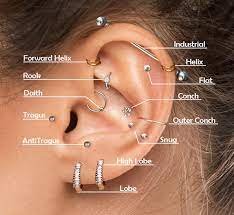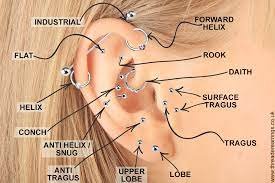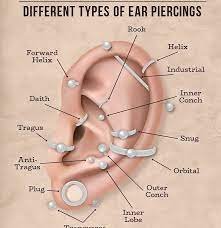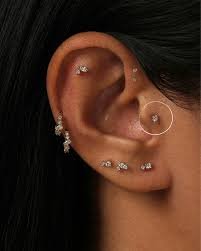The world of ear piercing is incredibly diverse, with numerous types and variations to choose from. From the classic lobe piercing to the exotic daith or the tragus, each carries its unique appeal and symbolism. This article will walk you through various types of ear piercings, and by the end, you’ll have a comprehensive “ear piercing chart” to navigate this exciting landscape.
Understanding Types of Ear Piercing

Lobe Piercing
The lobe piercing is the most common type of ear piercing. It involves perforating the fleshy, bottom part of the ear, often performed even on children due to its relative simplicity and low pain level. Variations include the Single Lobe, typically the first piercing one gets, and the Double and Triple Lobe, which add more studs going up the lobe.

Helix Piercing
Moving upwards along the ear, the Helix Piercing involves the upper cartilage rim. A classic Helix is towards the top, but there are multiple options here. A Double or Triple Helix follows the curvature of the ear with two or three studs. Forward Helix piercings are on the inner side of the upper cartilage, closer to the face.

Industrial Piercing
An industrial piercing, also known as a scaffold piercing, involves two holes in the upper ear cartilage. A single long barbell connects these two piercings. It’s a bolder statement and often takes longer to heal due to the two perforations.
Daith Piercing
The Daith piercing goes through the innermost cartilage fold of the ear. It’s a more unconventional option and is rumored to help with migraine relief, although the scientific evidence is lacking. The piercing itself is somewhat concealed, so jewelry choices play a big role in its visual impact.
Tragus Piercing
The tragus is the small, round piece of cartilage that juts out immediately in front of the ear canal. Tragus piercings can be a subtle statement and are popular for their unique location.
Anti-Tragus Piercing
Opposite the tragus, the anti-tragus is the raised fold of cartilage on the outer ear. Not everyone has a prominent anti-tragus, so this piercing isn’t as universally applicable. However, when feasible, it’s an interesting and unusual choice.
Conch Piercing
Named after the shell it resembles, the conch piercing targets the large area of cartilage making up the back of the ear. There are two types: the Inner Conch, which is the central part, and the Outer Conch, on the flat part in the upper outer ear. Both can host studs or hoops.
Rook Piercing
The rook is the thick fold of cartilage above the daith, along the inner ridge of the upper ear. A rook piercing is a vertical puncture, and due to the small, thick area it targets, it can be one of the more painful ear piercings.
Snug Piercing
Located in the inner cartilage area halfway down the outer rim of the ear, the snug, or anti-helix piercing, is a shallow piercing that’s quite specific to ear shape. It may not be suitable for everyone, but it can be a cool addition for those with the right anatomy.
Auricle Piercing
Situated on the outer part of the ear, between the earlobe and the helix, the auricle piercing punctures the ear’s middle cartilage. It’s a versatile choice that pairs well with lobe or helix piercings.

These are the primary categories of ear piercings, each with its individual aesthetic and implications. They can be personalized with different types of jewelry, like studs, hoops, barbells, or cuffs. Pain level, healing time, and aftercare procedures vary, so be sure to research thoroughly and consult a professional piercer before making a decision.
When it comes to ear piercings, the possibilities are near-endless. You can opt for a single piercing as a subtle embellishment or multiple ones for a curated, unique look. With this guide, you now have a “map” to navigate the landscape of ear piercings. The most important thing is to choose what resonates with your style and comfort, making sure to prioritize safety and hygiene in the process. So whether it’s a traditional lobe or a daring industrial piercing, embrace the self-expression that ear piercings offer and enjoy the journey.
Read More-

